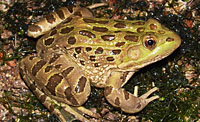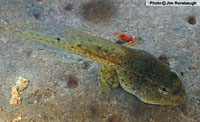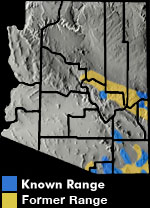Online Field Guide to The Reptiles and Amphibians of Arizona


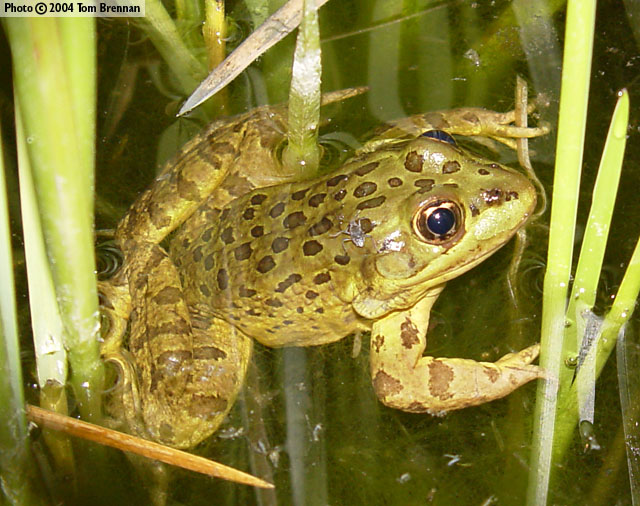
Apache County, AZ
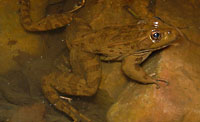 Gila Co., AZ |
| CHIRICAHUA LEOPARD FROG Lithobates chiricahuensis | |
|
DESCRIPTION: This leopard frog grows to about 4.3 inches in length, and is a green or brown frog with dorsolateral folds and numerous, relatively small dark spots. In southeastern Arizona, frogs are often green, or have green on the head. The Chiricahua leopard frog is distinguished from other Arizona leopard frogs by a combination of characters, including a distinctive salt and pepper pattern on the rear of the thigh of adults and some juveniles, dorsolateral folds that are interrupted and inset towards the rear; stocky body proportions; eyes that are relatively high and upturned on the head; and relatively rough skin on the back and sides. Compared to other leopard frogs, the tadpoles are relatively dark, mottled, and stocky. Tadpoles grow to > 3 inches. DISTRIBUTION: The Chiricahua leopard frog occurred historically in the mountains and valleys along the Mogollon Rim east of Camp Verde and the Verde River, but also in southeastern Arizona south of the Gila River from the Baboquivari Mountains east to Peloncillo Mountains. Although still fairly well distributed through this range, the species has disappeared from about 88% of its historical localities in Arizona. HABITAT: Historically it occurred in a variety of wetland habitats, but is now restricted primarily to stock tanks and other man-made waters, as well as headwater streams, ciénegas, and springs that lack introduced predators. Breeds in deeper pools and relatively calm water. BEHAVIOR: Can be found active day or night, although they are easier to find and observe at night with a headlamp or flashlight. This is probably the most aquatic of the native leopard frogs, but can move overland and along drainages during summer monsoons. DIET: The Chiricahua leopard frog presumably feeds upon a wide variety of invertebrates as well as some small vertebrates (including juveniles of their own kind). REPRODUCTION AND CALLS: Breeds primarily from April through October, but egg masses are unusual in June. Populations >5,900 ft breed June-August. Spherical egg masses of up to 1,485 eggs are laid in quiet pools, typically attached to vegetation. Tadpoles take 3-9 months to metamorphose, and some overwinter. Adult males give a distinctive advertisement call consisting of a relatively long snore of 1 to 2 seconds in duration. REMARKS: The range of the Chiricahua leopard frog in Arizona is split into southeastern and east-central (Mogollon Rim) disjunct populations that may be different species or subspecies. In addition, some authors consider frogs from the eastern slope of the Huachuca Mountains to be a separate species (Ramsey Canyon leopard frog, Rana subaquavocalis – see Platz 1993, but also Goldberg et al. 2004). The Chiricahua leopard frog (not including the “Ramsey Canyon leopard frog”) is listed as a threatened species under the Endangered Species Act. Causes of decline include chytridiomycosis (a fungal disease), predation by non-native species, habitat loss and degradation, and other factors. A Recovery Team has prepared a draft Recovery Plan. By Jim Rorabaugh FEDERALLY PROTECTED PROTECTED in AZ
Goldberg, C.S., K.J. Field, and M.J. Sredl. 2004. Mitochondrial DNA sequences do not support species status of the Ramsey Canyon leopard frog (Rana subaquavocalis). Journal of Herpetology 38(3):313-319. Platz, J.E. 1993. Rana subaquavocalis, a remarkable new species of leopard frog (Rana pipiens Complex) from southeastern Arizona that calls under water. Journal of Herpetology 27(2):154-162. Sredl, M.J., and R.D. Jennings. 2005. Rana chiricahuensis Platz and Mecham, 1979, Chiricahua leopard frog. Pages 546-549 in M.J. Lannoo (ed), Amphibian Declines: The Conservation Status of United States Species. University of California Press, Berkeley. Sredl, M.J., J.M. Howland, J.E. Wallace, and L.S. Saylor. 1997. Status and distribution of Arizona’s native ranid frogs. Pages 45-101 in M.J. Sredl (ed). Ranid frog conservation and management. Arizona Game and Fish Department, Nongame and Endangered Wildlife Program, Technical Report 121. U.S. Fish and Wildlife Service. 2006. Chiricahua leopard frog (Rana chiricahuensis) draft recovery plan. U.S. Fish and Wildlife Service, Region 2, Albuquerque, NM. (http://www.fws.gov/southwest/es/arizona/CLF.htm). |
|
Visit Partners in Amphibian and Reptile Conservation:


HOME
Copyright © 2023, Arizona Game and Fish Department. All rights reserved.
If you make use of the textual contents of this site in reports, publications, etc. please cite and credit the author(s) and photographer(s). All photos on this website are copyrighted. However, those found in the species account section may be used for any noncommercial scientific, educational, or conservation purposes provided that photographs are not altered and continue to bear the copyright symbol and name of the photographer. Please contact the photographer regarding commercial use of copyrighted photographs.










